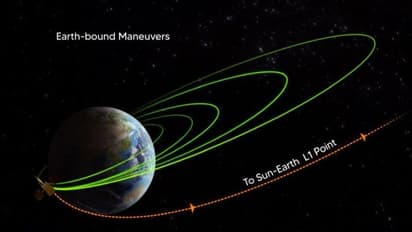ISRO's Aditya-L1 mission performs TL1I manoeuvre, on track to reach Sun-Earth L1 point

Synopsis
ISRO achieved a major achievement as its Aditya-L1 solar mission successfully executed the Trans-Lagrangean Point 1 Insertion (TL1I) maneuver, positioning the spacecraft on a trajectory towards the Sun-Earth L1 point. This marks the fifth consecutive success for ISRO in transferring objects to celestial destinations
The Indian Space Research Organisation (ISRO) announced a significant milestone for its inaugural solar mission, Aditya-L1, on Tuesday. The spacecraft has successfully executed the Trans-Lagrangean Point 1 Insertion (TL1I) manoeuvre, placing it on a trajectory toward the Sun-Earth L1 point. ISRO noted that this achievement marked the fifth consecutive instance of the agency successfully transferring an object to a trajectory leading to another celestial body or location in space.
A post on ISRO's official social media platform stated, "Aditya-L1 Mission | Off to Sun-Earth L1 point | The Trans-Lagrangean Point 1 Insertion (TL1I) manoeuvre is performed successfully. The spacecraft is now on a trajectory that will take it to the Sun-Earth L1 point. It will be injected into an orbit around L1 through a manoeuvre after about 110 days. This is the fifth consecutive time ISRO has successfully transferred an object on a trajectory toward another celestial body or location in space."
Previously, the Aditya-L1 spacecraft was launched from the Satish Dhawan Space Station in Sriharikota, Andhra Pradesh. The primary objectives of India's inaugural solar mission include gathering scientific data and achieving another milestone in the nation's solar exploration endeavours.
ISRO had previously shared on their platform, "Aditya-L1 Mission: Aditya-L1 has initiated the collection of scientific data. The sensors of the STEPS instrument have commenced the measurement of supra-thermal and energetic ions and electrons at distances exceeding 50,000 km from Earth. This data enables scientists to study the behaviour of particles in Earth's vicinity. The provided figure illustrates variations in the energetic particle environment, as recorded by one of the instruments."
The Supra Thermal and Energetic Particle Spectrometer (STEPS) instrument, a component of the Aditya Solar Wind Particle Experiment (ASPEX) payload, had also initiated its data-gathering operations earlier, further contributing to the mission's scientific goals.
What is Aditya-L1?
Aditya-L1 is India’s first space-based solar observatory. It is an unmanned spacecraft that will study the Sun from a distance of 1.5 million km from Earth. It was launched on September 2 from the Satish Dhawan Space Center in Sriharikota aboard the PSLV-C57 rocket. It is carrying seven payloads, with four for remote sensing of the Sun and three for in-position observation. The craft will attempt to study the Sun’s outer layers, such as the photosphere, chromosphere and corona. The mission is planned to last for five years.
What does the ‘L1’ in Aditya-L1’s name mean?
The 'L1' stands for Lagrange Point 1. Lagrange points are points in space where the gravitational pulls of two bodies are equal to the centripetal force needed for a small body to move with them, allowing the body to stay in relatively the same position. There are five Lagrange points in the Earth-Sun system, and the first point, L1, is where Aditya will be situated. This point affords an unbroken view of the Sun, letting Aditya observe it uninterrupted. The L1 point is also home to the Solar and Heliospheric Observatory Satellite (SOHO).
What does India want to learn from studying the Sun?
One unsolved mystery that Aditya wants to analyse is how the upper atmosphere of the sun has a temperature of 10,00,000 K (or around 10,00,000 °C) while the lower atmosphere has only a temperature of 6,000 K (or around 5,730 °C). It is also not understood how the Sun’s radiation exactly affects the Earth’s atmosphere on a shorter and longer time scale. By obtaining near-simultaneous images of both of the Sun’s atmospheric layers, the mission will help in understanding how these layers interact with each other and thus assist in solving some outstanding problems in solar physics and heliophysics.
What other countries are studying the Sun?
In recent history, the United States has been studying the Sun and its atmosphere. The Parker Solar Probe, a mission that is currently in progress, will attempt to analyse the outer corona, or outer atmosphere, of the Sun by progressively approaching it with high-speed flybys. At its closest point to the Sun, it will be at a distance of 6.9 million km from the Sun. While this does not seem like much, it should be kept in mind that the distance of the Earth from the Sun is 150 million km, so the probe is passing quite close to the Sun. The European Space Agency’s Solar Orbiter will aim to analyse the Sun’s heliosphere and solar wind, also studying the polar regions, which is difficult to do from Earth.
With inputs from Eva Kapoor
Stay updated with the Breaking News Today and Latest News from across India and around the world. Get real-time updates, in-depth analysis, and comprehensive coverage of India News, World News, Indian Defence News, Kerala News, and Karnataka News. From politics to current affairs, follow every major story as it unfolds. Get real-time updates from IMD on major cities weather forecasts, including Rain alerts, Cyclone warnings, and temperature trends. Download the Asianet News Official App from the Android Play Store and iPhone App Store for accurate and timely news updates anytime, anywhere.